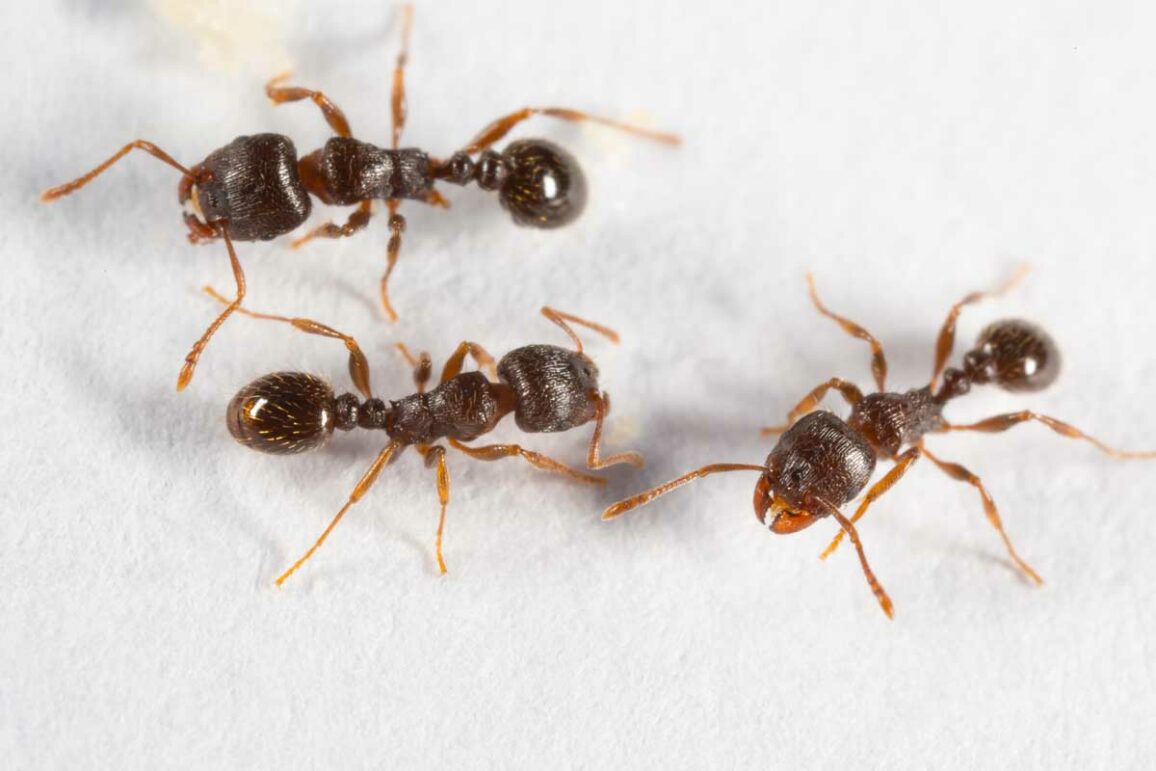Pavement ants, or Tetramorium caespitum, are a common sight in many parts of the UK. Originally from Europe, these tiny creatures have made themselves quite at home in the UK, often causing significant problems for homeowners. In this article, we’ll delve into the world of pavement ants and explore effective strategies for controlling and eradicating them.
Identification and Distribution

Pavement ants are small, about 1/8 inch long, and are dark brown to black in colour. They are often confused with the odorous house ant, another common pest found throughout the UK. However, pavement ants can be distinguished by two nodes in front of their abdomen, fine grooves on their head and thorax, a cluster of hairs on the end of their abdomen, and two spines on their backs.
These ants are not native to the UK but are believed to have been introduced from Europe in the 1700s and 1800s via ships carrying soil as ballast.
Biology and Behaviour

Pavement ants get their name from their habit of nesting in pavements, sidewalks, driveways, or patios. They leave characteristic mounds of sand or dirt near their nests, which can also be found in lawns, gravel pathways, or under floorboards. Their colonies have multiple queens and many workers.
These ants are not fussy eaters. They will feed on fruit, nectar, honeydew from aphids, dead insects, small seeds, and even human and pet food. They are most active at night, often found making their way across kitchen floors in search of food.
Colonisation of Houses
Pavement ants frequently enter homes through cracks in floorboards, interior slabs, and the foundations of buildings. Once inside, they will make their nests under floors, in-wall or attic insulation, under carpets, and in moist places such as under sinks or by toilets.
Control and Eradication
Controlling an infestation of pavement ants requires a strategic approach. The key is to destroy the colony by killing the queen. This is why insecticidal sprays are often ineffective. They will simply kill the visible workers, but a short time later, new ones will be back to take their place.
Instead, the use of insecticidal baits is recommended. The workers feed on the bait and carry it back to the nest to feed the queen. Slow-acting insecticide is ideal for this, as it gives the workers time to take the poison back to the colony before they die.
Ant Bait
The broad diet of pavement ants gives homeowners many options in the choice of bait. Protein- or sugar-based bait stations pre-filled with pesticides are the most convenient. It’s best to use two types of bait at once – one that is sugar-based and one that contains protein.
Common insecticides for use in bait traps include boric acid, fipronil, and hydramethylnon. Boric acid has very low levels of toxicity to people but it’s very toxic to insects. Fipronil is commonly used as a flea and tick treatment for dogs and cats.
The bait should be placed near their colonies if you can find them, or next to their trails. It can take two weeks or more to control an infestation using bait traps. However, it’s important to remember that insects are much more sensitive to the low level of pesticides in these products than people or pets. Therefore, care should be taken when using any chemicals around your property or in your home.
In conclusion, while pavement ants can be a nuisance, they are a controllable pest. With the right knowledge and tools, homeowners can effectively manage and eradicate these tiny invaders.
Frequently Asked Questions
What are pavement ants and where do they come from?
Pavement ants, scientifically known as Tetramorium caespitum, are a type of ant originally from Europe. They were introduced to the UK in the 1700s and 1800s and have since become a common pest. They are named for their habit of nesting in and around pavements, sidewalks, and driveways.
How can I identify pavement ants?
Pavement ants are small, about 1/8 inch long, and are dark brown to black. They can be distinguished from other ants by two nodes in front of their abdomen, fine grooves on their head and thorax, a cluster of hairs on the end of their abdomen, and two spines on their backs. They also leave characteristic mounds of sand or dirt near their nests.
What do pavement ants eat?
Pavement ants have a broad diet. They feed on fruit, nectar, honeydew from aphids, dead insects, small seeds, and even human and pet food. They are most active at night and are often found in kitchens in search of food.
How do pavement ants infest houses?
Pavement ants frequently enter homes through cracks in floorboards, interior slabs, and the foundations of buildings. Once inside, they make their nests under floors, in-wall or attic insulation, under carpets, and in moist places such as under sinks or by toilets.
What is the most effective way to control a pavement ant infestation?
The most effective way to control a pavement ant infestation is to use insecticidal bait. The ants feed on the bait and carry it back to their nest to feed the queen, effectively poisoning the colony. It’s recommended to use both protein- and sugar-based baits. Common insecticides include boric acid, fipronil, and hydramethylnon. It can take two weeks or more to control an infestation using bait traps.
You may also enjoy reading this article
Was This Article Helpful?
- Please provide feedback and comments to help us improve our content.
- Share your experiences and any additional tips you have for dealing with pests.
Share this Post



